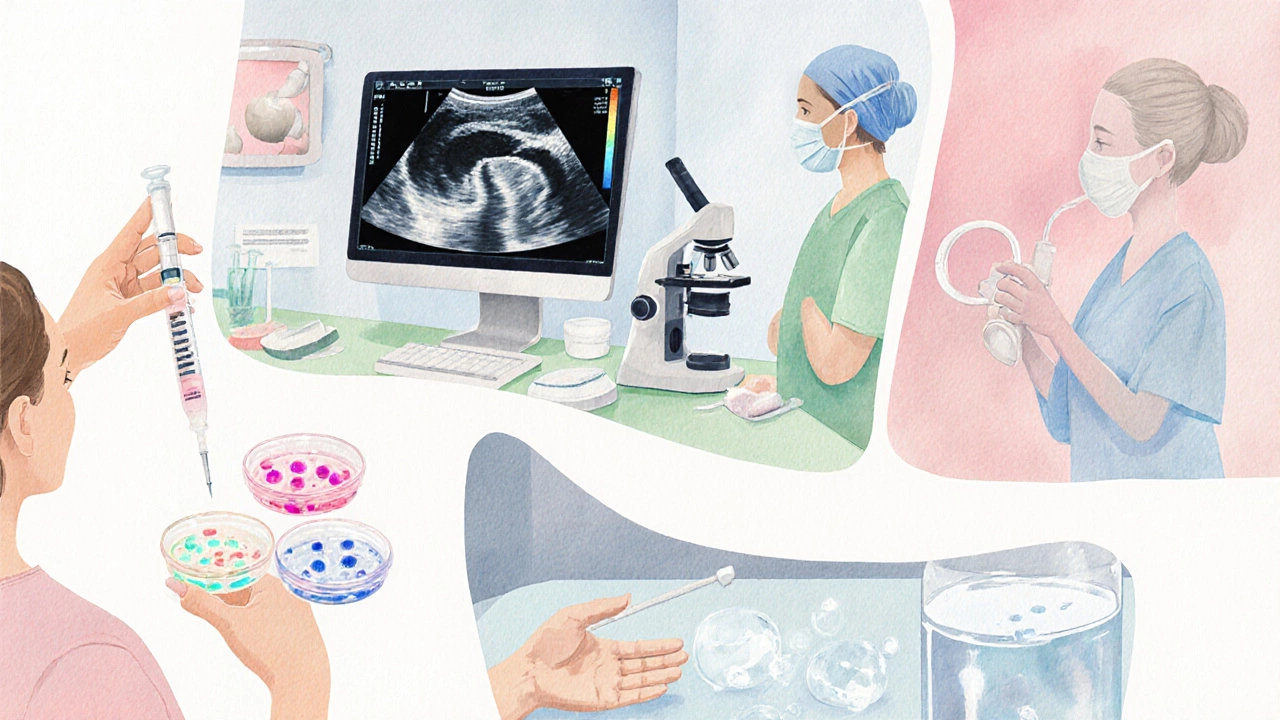IVF Cost Calculator
Estimate Your IVF Cycle Cost
Get a personalized estimate based on your chosen package and add-ons
Estimated Total Cost
Note: These are approximate estimates based on 2025 prices in India. Costs may vary by location and clinic.
Cost Comparison
Your Indian estimate is approximately of US costs.
When people talk about In Vitro Fertilization (IVF) is a medical procedure that helps couples conceive by combining eggs and sperm outside the body and then transferring embryos back into the uterus, the first question that comes up is the price tag. In 2025, the cost varies wildly by country, clinic type, and the services you add, but most patients in India wonder if a single round will fit into their budget. Below is a clear, no‑fluff look at what you actually pay for, why numbers differ, and how to keep the expense under control.
What’s included in an IVF round?
An IVF cycle typically consists of several distinct steps, each with its own cost line item:
- Ovarian stimulation drugs - hormones that coax the ovaries to produce multiple eggs.
- Monitoring appointments - blood tests and ultrasounds to track follicle growth.
- Egg retrieval - a minor surgical procedure performed under sedation.
- Sperm preparation - processing the male partner’s sample or donor sperm.
- Laboratory work - fertilizing the eggs, culturing embryos, and sometimes doing ICSI (intracytoplasmic sperm injection).
- Embryo transfer - placing one or more embryos into the uterus.
- Cryopreservation - freezing any extra embryos for future attempts.
Each of these components can be billed separately, and clinics often package them differently. Knowing the breakdown helps you spot hidden fees.
How clinics price IVF
Most fertility centers publish a “package price” that bundles the core steps, but the fine print varies:
- Base package - typically includes stimulation drugs, monitoring, retrieval, fertilization, and the first embryo transfer.
- Add‑ons - ICSI, pre‑implantation genetic testing (PGT), assisted hatching, or additional frozen embryo transfers.
- Facility fees - operating room charges, anesthesia, and lab overhead.
- Administrative costs - paperwork, counseling, and sometimes a “clinic success‑rate premium.”
In India, many clinics differentiate between a “standard” and a “premium” package. The standard version may use generic gonadotropins, while the premium uses newer recombinant hormones that can be 30 % more expensive but claim higher yields.
Typical IVF cost breakdown in India (2025)
| Component | Average Cost (INR) | Notes |
|---|---|---|
| Ovarian stimulation drugs | ₹80,000 - ₹120,000 | Depends on brand (generic vs recombinant) |
| Monitoring (blood tests & ultrasounds) | ₹15,000 - ₹25,000 | Usually 6‑8 visits |
| Egg retrieval (procedure & anesthesia) | ₹30,000 - ₹45,000 | Includes day‑care facility fee |
| Lab work (fertilization, culture) | ₹35,000 - ₹50,000 | Basic IVF; ICSI adds ₹15,000‑₹20,000 |
| Embryo transfer | ₹20,000 - ₹30,000 | Single or double transfer |
| Cryopreservation (freezing + storage) | ₹10,000 - ₹15,000 per embryo | Yearly storage about ₹3,000‑₹5,000 |
| Package total (standard) | ≈ ₹190,000 - ₹285,000 | ≈ $2,300 - $3,450 (USD) |
These figures are averages gathered from top clinics in Bangalore, Delhi, and Mumbai. Prices in tier‑2 cities can be 10‑20 % lower, while luxury centers in metropolitan hubs may charge a premium for private rooms and personalized care.

Cost comparison: India vs United States vs United Kingdom
International patients often ask how Indian prices stack up against Western markets. Here’s a quick snapshot (2025 figures):
| Country | Base Package | Typical Add‑ons | Total (incl. meds) |
|---|---|---|---|
| India | $1,200 - $1,800 | $300 - $700 | $1,600 - $2,500 |
| United States | $10,000 - $12,000 | $2,000 - $5,000 | $12,000 - $17,000 |
| United Kingdom | £5,000 - £6,500 | £1,000 - £2,500 | £6,000 - £9,000 |
Even after accounting for travel and accommodation, many Indian couples find that a single Indian cycle costs less than a half of a US cycle. That’s why medical tourism for IVF remains a booming segment.
Factors that can raise or lower the price
Not every IVF journey looks the same. Here are the biggest cost drivers you’ll encounter:
- Age of the woman - older patients often need higher drug doses, pushing medication costs up by 20‑40 %.
- Number of embryos transferred - a double transfer isn’t much more expensive than a single, but it can affect success rates and future frozen cycles.
- Use of ICSI - required for male factor infertility; adds a flat fee.
- Pre‑implantation genetic testing (PGT) - screens embryos for chromosomal issues; each test can cost $1,200‑$2,500.
- Clinic reputation - high‑success clinics often charge a “premium,” though the correlation isn’t always linear.
- Insurance coverage - a handful of Indian insurers now offer partial IVF reimbursement, reducing out‑of‑pocket spend.
Conversely, opting for generic gonadotropins, limiting monitoring visits, or choosing a clinic with transparent pricing can shave off 10‑15 % of the total.

Financing options and insurance
Even if the sticker price seems high, several avenues exist to soften the blow:
- EMI plans - many hospitals partner with banks to offer low‑interest monthly installments.
- Package discounts - booking two cycles together can cut 5‑10 % off each.
- Government schemes - certain state health programs in Karnataka provide subsidies for low‑income couples.
- Employer benefits - a growing number of multinational firms in Bangalore include fertility coverage in their health packages.
- Crowdfunding - platforms like Ketto and GoFundMe are commonly used for IVF fundraising.
When you speak to a clinic’s financial counselor, ask for a detailed invoice that lists every line item. That transparency makes it easier to compare offers and claim reimbursements.
Tips to keep the cost manageable
Here are practical steps you can take right now:
- Schedule a pre‑treatment consult with a fertility specialist to determine the exact medication dose you’ll need - a tailored plan avoids over‑prescribing.
- Ask if the clinic offers a “drug‑free” monitoring option, where fewer ultrasounds are used without compromising safety.
- Consider a single embryo transfer (SET) if your clinic’s success rates for SET are above 50 %; it reduces the need for extra frozen cycles.
- Shop around for generic gonadotropins - reputable pharmacies in Bangalore often provide a 15‑20 % discount compared to branded versions.
- Bundle your IVF cycle with a male partner’s sperm analysis; many labs waive additional fees if done together.
Remember, the goal isn’t to cheap‑enjoy the journey but to get the best value for each dollar you spend.
Bottom line: how much is one round of IVF?
The short answer: in India, a standard IVF round in 2025 typically lands between ₹190,000 and ₹285,000 (about $2,300‑$3,450). Add‑ons like ICSI or genetic testing can push the total toward ₹350,000. Compared with the U.S. or U.K., you’re looking at roughly one‑quarter to one‑third of the cost, even after factoring travel.
Understanding each cost component, asking the right questions, and leveraging financing options can turn the price from a shock into a manageable part of your family‑building plan.
What does a typical IVF package include?
A standard package covers ovarian stimulation drugs, monitoring appointments, egg retrieval, lab fertilization, embryo transfer, and usually one frozen embryo for future use. Add‑ons like ICSI, PGT, or extra frozen embryos are billed separately.
Why do IVF costs differ so much between clinics?
Differences arise from drug brands (generic vs recombinant), facility overhead, success‑rate premiums, and whether the clinic bundles services or charges them a la carte. Transparency varies, so always request a detailed breakdown.
Is IVF covered by insurance in India?
A few private insurers now offer partial reimbursement for IVF, especially for salaried professionals. Government schemes in certain states also provide subsidies for low‑income couples.
Can I reduce the medication cost?
Yes. Ask your doctor to tailor the dose to your ovarian reserve, and consider buying generic gonadotropins from reputable pharmacies, which can be 15‑20 % cheaper than branded versions.
What financing options are available?
Many clinics partner with banks for low‑interest EMIs, offer discounts for booking multiple cycles, and accept employer‑provided fertility benefits. Some couples also use crowdfunding platforms to offset costs.

 Understanding the Downsides of Mail-Order Pharmacies
Understanding the Downsides of Mail-Order Pharmacies
 Psychologist vs Therapist: Which Mental Health Expert Is Right For You?
Psychologist vs Therapist: Which Mental Health Expert Is Right For You?
 Why Therapists Watch Your Hands: Understanding Non‑Verbal Cues
Why Therapists Watch Your Hands: Understanding Non‑Verbal Cues
 Success Rate of IVF: How Likely Is It to Work on the First Try?
Success Rate of IVF: How Likely Is It to Work on the First Try?
 What’s Taking Over from Metformin in Diabetes Care?
What’s Taking Over from Metformin in Diabetes Care?